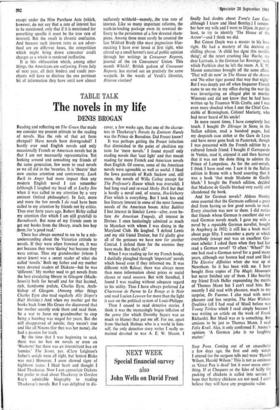Truth on tick
CONSUMING INTEREST LESLIE ADRIAN
On 29 May this year, the President of the United States signed into law a bill which will force creditors to put in their contracts most of the information consumers need in order to buy credit wisely. Five weeks later, our own Presi- dent (of the Board of Trade) announced that in consultation with the Chancellor he was appointing a committee, under Lord Crowther's chairmanship, to make a wide-ranging review of consumer credit in this country. In America it has taken a generation-long period of criticism and eight years of Congressional struggle to enact legislation indispensable for a nation that buys on the cuff and for an economy now under- pinned by an instalment debt of $78 billion. I devoutly pray that Britain does not have to wait that long for similar protection and reform. For here, too, 'in the midst of life we are in debt,' and here, too, most of us are committing our- selves to such debt without knowing its true cost.
To an older generation, buying now and pay- ing later was anathema. When my own grandpa repeated the maxim 'pay as you go, or don't go,' he thought of himself as expressing not only robust commonsense but plain morality. Polonius had similar views. But today the shame that once attached to borrowmanship has
'.•. . So if Zurich pressures us into an exchange-rate of two hundred cowrie shells to the dollar, we'll give 'em two hundred cowrie shells to tire dollar. . . . That'll teach 'ern?' vanished almost without trace, and what re- mains is not aversion from the game but simple ignorance of its rules—indeed, in most in- stances, an absence of any effective rules at all. Few of us really know how much we might be in pocket if we used one method of borrowing rather than another. Partly this may be because we're not all that good at arithmetic. But mainly it is because different agencies of borrowing use different ways of telling customers what they're paying in order to borrow.
Suppose, for example, that you put central heating into your home costing £500 and want to borrow the money and pay it off by monthly instalments. There are in normal times various methods of going about this, but let us just look at two. Method A is with a finance company loan provided through an oil firm. The leaflet says that the interest is 4-1 per cent a year. (There is some explanation about how this is arrived at but. unle;,, ou are financially fly, what sticks in your mind is going to be the 41 per cent.) Method B -available, of course, only for the kind of persuasive paragon who can take credit squeezes and Saturday closing in his stride— is to get a loan from your bank. The interest, the manager tells you, is 9 per cent. Now which do you choose? Plenty of people would jump at method A. Yet for most the interest charges on B. assuming repayments over the same period, could add up to £50 less than those on A. So an apparently dearer method can be a better buy than an apparently cheaper one.
Why should tick be so topsy-turvy? First, because lenders often quote the rate of interest as a yearly percentage of the original amount of the loan, and not of the decreasing amounts you owe as you gradually pay it back. Secondly, because they sometimes quote the rate net-of- tax, that is to say taking into account tax relief you might be entitled to on the amount of in- terest you pay, although that naturally varies from one person to another. By using one or a combination of these methods of presentation, interest rates to borrowers can be advertised at a figure which may be half or even a third Of the true rate of interest. This is quite legal-
except under the Hire Purchase Acts (which, however, do not say that a rate of interest has to be mentioned, only that if it is mentioned for something specific it must be the true rate of interest). But the result is chronic confusion. And because such interest rates as are adver- tised are on different bases, the competition which might bring down consumer credit charges as a whole is rendered ineffective.
It is this obfuscation which, among other things, the Americans are outlawing. From July of next year, all their lenders and credit mer- chants will have to disclose the one pertinent bit of information they have until now almost uniformly withheld—namely, ,the true rate of interest. Like so many important reforms, the truth-in-lending package owes its eventual de- livery to the persistence of a few devoted cham- pions. Among these must surely be counted the late Mildred Brady (the most pugnacious stocking I have ever loved at first sight, who stirred up a small hornet's nest of public opinion through her writings in Consumer Reports, journal of the us Consumers' Union. This month Which?, British godson of Consumer Reports, has started out on precisely the same warpath. In the words of Verdi's librettist, Ritorna vincitorl











































 Previous page
Previous page